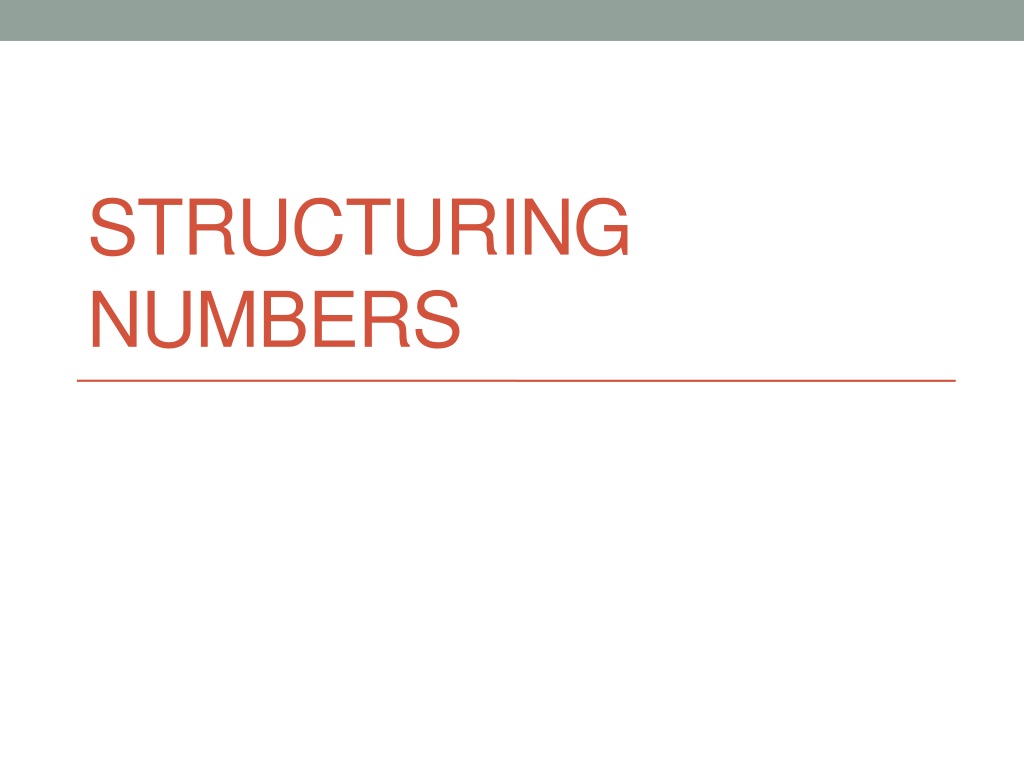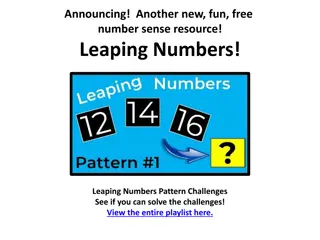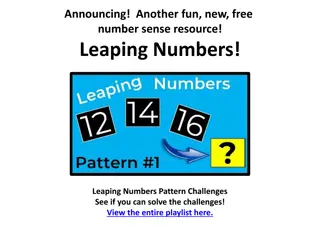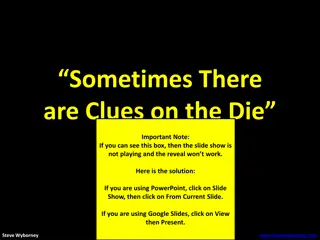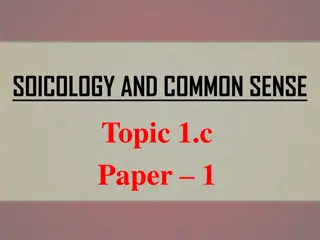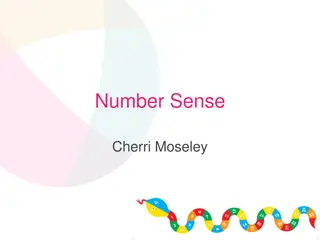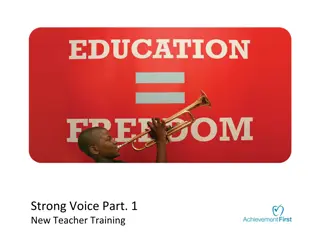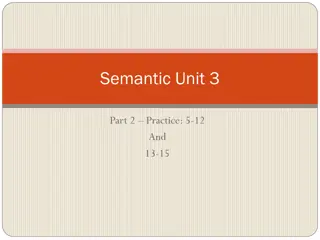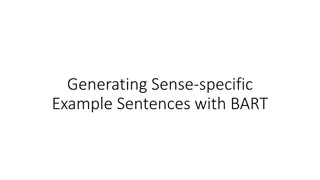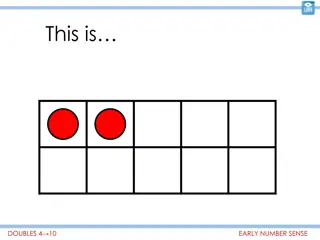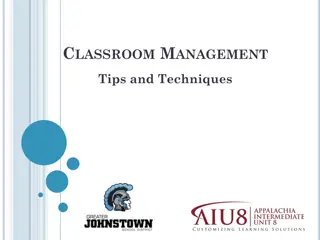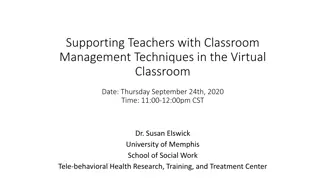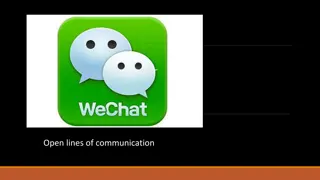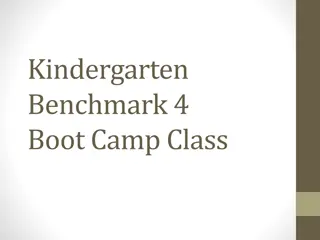Developing Number Sense in the Classroom
Explore various strategies to help young children develop number sense, including subitizing, finger patterns, spatial patterns, pair-wise patterns, five-wise patterns, partitions of five and ten, and adding and subtracting to 10. These activities involve using visual aids, dice patterns, finger counting, and interactive exercises to enhance understanding of numbers and basic mathematical operations.
Download Presentation

Please find below an Image/Link to download the presentation.
The content on the website is provided AS IS for your information and personal use only. It may not be sold, licensed, or shared on other websites without obtaining consent from the author.If you encounter any issues during the download, it is possible that the publisher has removed the file from their server.
You are allowed to download the files provided on this website for personal or commercial use, subject to the condition that they are used lawfully. All files are the property of their respective owners.
The content on the website is provided AS IS for your information and personal use only. It may not be sold, licensed, or shared on other websites without obtaining consent from the author.
E N D
Presentation Transcript
STRUCTURING NUMBERS
NUMBERS 1 TO 10 Teaching Number in the Classroom, Wright et al, 2006
Subitising Ascribing numerosity to a collection of items immediately and without counting, typically up to 5 or 6 items Regular patterns can be important for young children s learning dot cards, dice and domino patterns Move on to five frames and ten frames Gradually lessen time pattern is displayed
Finger Patterns Encourage use of finger patterns in the early years Patterns to five on one hand first Observe sequential or simultaneous? Do they need to see fingers? Move on to patterns 6 to 10 five and . Doubles for numbers 1 to 5 Different ways to make numbers
Spatial patterns Start with dice patterns 1 to 6 Flash in random order What do you see? What does the four pattern look like? Can you show me in the air? Tap it on the table? Ideas finger painting, playdough, counters or objects, taking photographs, link to numerals .
Pair-wise Patterns Flash ten frames with pair-wise patterns in random order How many dots do you see? What does three look like? Can you show me in the air? Show vertically with dots filled from bottom Ideas?
Five-wise Patterns Flash ten frames with five-wise patterns in random order How many dots do you see? What does eight look like? Can you show me in the air? Show vertically with dots filled from bottom Ideas?
Partitions of five and ten I will say a number and you say the numbers that goes with it to make five Show on ten frame or five frame Discuss were you right? What ones are tricky? How did you know? Once they know five, move on to ten
Adding and Subtracting to 10 Flash the pair-wise pattern for 6 what number did you see? What is 6 and 2? How did you work it out? Show first number only. Repeat with different examples. Flash five-wise pattern for 7. What did you see? What is 7 and 3? How did you know? Repeat with different examples Try with subtraction. Remember just to listen to how the child works it out don t expect them to use particular strategies or patterns
Bunny Ears Helps develop awareness of combinations and partitioning numbers to 10 Discuss different ways to make numbers Try to do this without looking, but may have to look to check at first Try showing a ten frame pattern and asking for Bunny Ears for that amount Try with numeral cards
Quick dots Flash regular dice patterns for half a second how many did you see? Initially they may memorise pattern, then count Describe the arrangement of dots Move on to irregular patterns Make with counters
Make Five Concentration Arrange a set of twelve five frame cards (2 sets 0 5) face down on table Children try to collect pairs that add to five Winner has most pairs! Lots of opportunity for discussion and questioning Try varying with numeral cards, or a mixture
Five and Ten frame flashes Show five frame on Smartboard how many squares? Add three dots. How many dots? How many empty squares? Move on to flashing five frame patterns half a second Vary single decker and double decker buses, own boards and counters, children as teacher
Memory Game Use two or four sets of either pair-wise or five-wise ten frame patterns mix up and place face down Children find pairs Vary five frames, numeral cards, mix of pair-wise and five-wise patterns
Domino patterns Display large domino card. How many dots can you see? How many on each side? Show me a finger pattern Domino Fish ask for a particular card Domino Snap matching numerals
Make Ten Fish Use numeral cards 1 to 9 (at least four sets) Deal five cards to each player remaining cards in pile in middle of table Players take turn to ask another player for a particular card aim is to make a pair that equals ten If player doesn t have the card they say Go Fish! and the seeker takes the top card from the pile in the middle The game continues till one player has no more cards winner is the one with most pairs
Rekenrek Also known as Arithmetic Rack Make me Work with numbers in groups 1-5, 6-10, 11-15, 16-20 Goal is to be able to make numbers in one or two quick moves without needing to count Two ways five/ten structure and doubles structure Lots of opportunities for discussion, questions, sharing and making connections
Rekenrek Reading numbers on rack . Teacher screens then flashes how many? Different ways to make . Adding two numbers use two rows and encourage lots of different ways to work out Child is ACTIVE not told what to do, or following expectations
Rekenrek Doubles and near doubles Five and .to ten Facts to 5 Ten and . Five and .to fourteen Facts within ten one addend 6 9, other 1 4 Facts within twenty two addends in range 6 9 Make link between commutations too (turnarounds)
Rekenreks Make a pair-wise pattern for 7 screened, then flash. What did you see? Repeat with other numbers to 10. What does 5 look like on the rack when I am building pairs? Repeat with other numbers Repeat for five-wise patterns Show in two different ways two rows, or top row only Link to ten frames Move on to patterns for 11 to 20 pair-wise, then five-wise 11 to 14 and ten-wise for 15 - 20
Rekenreks Adding doubles, fives, tens, e.g. make a five-wise 9 using top row and flash. What did you see? Show card 9 + 3. Use the rack to work this out how did you do it? Look for children using patterns, but try not to communicate expectations Move on to Subtraction
Double Decker Bus Flashes Show empty bus available from disc Flash doubles combinations Flash ten and combinations Children make given numbers of people on the bus How many ways could 12 people be arranged on the bus? Lots of discussion. Driver likes all the lower row filled first ten plus! Getting on and off the bus
Bus Games Bus snap numeral cards Fish combinations to 20
Ten and. Show 9 on the lower row and 6 on the upper row. What if one person comes down to sit on the lower row? How many now? Record and discuss Children can change different upper/lower combinations to ten and combinations Move on to screening, then without bus
Five and Ten Games Two dice 1-6 and one with just numbers 5 and 10. Roll both dice and record combinations on game sheet Double ten frame cards flash and record facts for each. How many in top row? Bottom row? How many altogether? How many more to make twenty? Write on back of card so children can test each other. Bead strings make different combinations to explore number relationships
DEVELOPING FURTHER. Developing Number Knowledge, Wright et al, 2012
Moving on. Tally Marks help children learn to count using five, and helps develop knowledge of five and facts Use these in any classroom scoring game for any context Model counting in fives and discuss why we find this useful as adults Talk about why we group things like this
Ten frames Flash five-wise patterns how many on the top? Bottom? How many altogether? How many more to make ten? Vary the length of time displayed move to 0.5 second! Continue with other patterns If needing to count, use empty ten frames and counters to scaffold children recreate flashed pattern Discuss other patterns that might make the same number
Go Fish Use mini ten frames six full sets Play game, aiming to match pairs that add to ten Move on to numeral cards, or playing cards Extend to pairs to twenty Vary Kim s Game
I Wish I Had Use rekenreks, and ask children to build the number you say on their racks. I wish I had .8. Choose children to explain how they made 8. Share different patterns and discuss Repeat with different numbers up to 20 Discuss how many pushes? Increase pace as confidence grows. I wish I had 11. I have 11. I wish I had 14. Pause and discuss number of pushes. Repeat 5, 10, 15 and 20 several time to draw attention to these numbers Observe numbers that are easier/trickier or requiring more moves and target numbers as needed. Target related patterns, e.g. I wish I had 12: I have 12. I wish I had 7 look for children removing just one push of 5.
Double-decker Bus Rekenrek for each child Tell story of double decker bus driving around with passengers getting on and off. Ask children to represent with rack, e.g. there are 9 people on the bus and 7 more get on. How many now? Discuss how we used the rack I had 9 on the top row and 7 on the bottom I moved 1 passenger to the top deck which made 10 and 6, so 16. Share different ways. Discuss which was quicker? Vary story contexts as relevant to your children!
9 Plus Game Materials 9 plus Game Board, 4 9 Spinner, paper clips and pencil, counters. Player spins and adds the number spun to nine. They give number sentence and puts counter on the answer number on the board. Aim is to get three in a row. Look for quick strategies, e.g. rounding and compensating Vary with 8 Plus, or 19 Plus
20 Minus Game Use 20 Minus Game Board, 0-9 Spinners, paper clip and pencil, counters As previous game, but subtract spun number from 20 Vary numbers to extend decuple numbers
Make Six Numeral cards 1 6 at least six sets for a group Show examples of cards totalling 6, e.g. 4 and 2 or 3, 2 and 1 Ask each group to find all the different ways to make up a total of six not just two numbers, but ALL Vary resources Numicon, cubes, or just verbally. Discuss how will we know we have found ALL the combinations? Great opportunity for mathematical reasoning and organisation! Record combinations and share. Extend with other numbers!
Crackers the Parrot Hold up a puppet (parrot or otherwise!) He can only say five . We want to make him look clever can you ask him problems with the answer five? He only answers five to the correct questions! Follow up with rekenrek to model for younger children Problems can be as hard as they like record all the problems they come up with answering five Vary numbers to challenge and extend For older children, just use Target Number, and generate as many ways to reach that number as possible!
Addition Card Families Set of cards for each group. A set would be all the additions with totals in the range 1 to 10 for example. As a child reads out their addition card, children match their cards with the same answer to make families of each number. Share additions for each family Look for relationships, turnarounds, doubles and near-doubles. Discuss tricky facts. How else could we sort into families? E.g. doubles, Five plus facts, near doubles? What if they belong in more than one family? What is the BEST way to organise? Why? How quickly can you sort them? How many combinations for each family?
Bulls-eye Dice 4 standard dice per pair, or 4 giant dice for whole class version Player rolls 4 dice. Then they choose some of the numbers to add together, to make a total as close as possible to the bulls- eye of 10. Give a score according to how close to bulls-eye, e.g. 8 or 12 get 2, 9 and 11 get 1, 10 gets 0. Record scores for each player, and the number sentence and total on a table. Dice Number sentence Total Score 6 4 3 2 5 3 3 1 6 + 4 5 + 3 + 3 10 11 0 1 Players play six rounds and winner is player with lowest score Vary use ALL FOUR dice, add OR subtract, Bonus Die, Whole class play 20 seconds to write down best combination.
Numicon https://global.oup.com/education/content/primary/series/n umicon/?region=international&view=ProductList&facet_ty pe_facet=Teaching%20Support&start=0
Highland Numeracy Blog https://highlandnumeracyblog.wordpress.com/
Maths Recovery http://www.mathsrecovery.org.uk/resources/
Rekenreks http://bridges1.mathlearningcenter.org/media/Rekenrek_0 308.pdf https://www.youtube.com/watch?v=B4_YvwpIQwU http://www.ictgames.com/brilliant_beadstring_with_colour. html
Significance of structuring numbers Developing thinking about how numbers are structured helps children develop non-count-by-one strategies Giving numbers STRUCTURE by thinking of them as constructed from smaller parts helps them organise numbers to make them easier to work with They can them partition or combine numbers to work out problems mentally This combination of knowledge of number structure and developing strategies leads to .MENTAL AGILITY!
Resources Think about how you can use the resources you have . How could you vary the activities, or link resources? Could you arrange to share resources between stages at set times to allow for group or class sets? Share other great ways to use your resources so others can learn from you!
